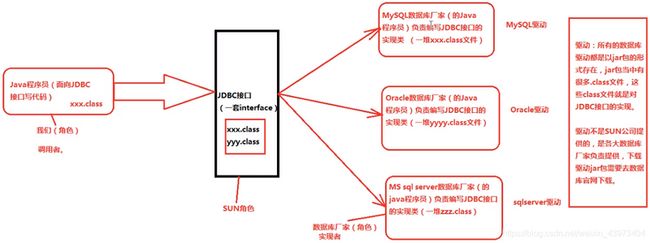1.JDBC是什么?
Java DataBase Connectivity(Java语言连接数据库) 2.JDBC的本质是什么?
JDBC是SUN公司制定的一套接口(interface)
java.sql.*; (这个软件包下有很多接口。) 3.JDBC开发前的准备工作,先从官网下载对应的驱动jar包,然后将其配置到环境变量classpath当中。
classpath=.;D:course06-JDBCresourcesMySql Connector Java 5.1.23mysql-connector-java-5.1.23-bin.jar
以上的配置是针对于文本编辑器的方式开发,使用IDEA工具的时候,不需要配置以上的环境变量。
IDEA有自己的配置方式。 4.JDBC编程六步(需要背会)
第一步:注册驱动(作用:告诉Java程序,即将要连接的是哪个品牌的数据库)
第二步:获取连接(表示JVM的进程和数据库进程之间的通道打开了,这属于进程之间的通信,重量级的,使用完之后一定要关闭通道。)
第三步:获取数据库操作对象(专门执行sql语句的对象)
第四步:执行SQL语句(DQL DML....)
第五步:处理查询结果集(只有当第四步执行的是select语句的时候,才有这第五步处理查询结果集。)
第六步:释放资源(使用完资源之后一定要关闭资源。Java和数据库属于进程间的通信,开启之后一定要关闭。) import java.sql.Driver;
import java.sql.DriverManager;
import java.sql.SQLException;
import java.sql.Connection;
import java.sql.Statement;
public class JDBCTest{
public static void main(String[] args)
{
Connection conn= null;
Statement stmt = null;
ResultSet rs = null;
try{
//1.注册驱动
//第一种方式
Driver driver = new com.mysql.jdbc.Driver();
DriverManager.registerDriver(driver);
//第二种方式(一下方法不需要返回值,我们只需要它的类加载动作)
class.forName("com.mysql.jdbc.Driver");
//2.获取连接
String url = "jdbc:mysql://127.0.0.1:3306/bjpowernode";
String user = "root";
String password = "333";
conn = DriverManager.getConnection(url,user,password);
System.out.println("数据库连接对象:"+conn);
//com.mysql.jdbc.JDBC4Connection@34340fab
//3.获取数据库操作对象(statement专门执行sql语句)
stmt = conn.createStatement();
//4.执行sql
String sql = "select empno as a,ename,sal from emp";
rs= stmt.executeQuery(sql); //executeUpdate执行DML语句 executeQuery(sql)执行DQL语句
//5.处理查询结果集
while(rs.next())
{
int empno = rs.getInt("a");
String ename = rs.getString("ename");
double sal = rs.getDouble("sal");
System.out.pritnln(empno+","+ename+","+sal);
}
}
catch(SQLException e){
e.printStackTrace();
}finally{
try{
if(stmt !=null){
stmt.close();
}
}catch(SQLException e){
e.printStackTrace();
}
try{
if(conn !=null){
conn.close();
}
}catch(SQLException e){
e.printStackTrace();
}
}
}
}使用属性配置文件
//jdbc.propertes属性配置文件
driver=com.mysql.jdbc.Driver
url=jdbc:mysql://localhost:3306/bjpowernode
user=root
password=333import java.sql.Driver;
import java.sql.DriverManager;
import java.sql.SQLException;
import java.sql.Connection;
import java.sql.Statement;
import java.util.*;
public class JDBCTest{
public static void main(String[] args)
{
//使用资源绑定器绑定属性配置文件
ResourceBundle bundle = ResourceBundle.getBundle("jdbc");
String driver = bundle.getString("driver");
String url = bundle.getString("url");
String user = bundle.getString("user");
String password = bundle.getString("password");
Connection conn= null;
Statement stmt = null;
try{
//1.注册驱动
class.forName(driver);
//2.获取连接
conn = DriverManager.getConnection(url,user,password);
System.out.println("数据库连接对象:"+conn);
//com.mysql.jdbc.JDBC4Connection@34340fab
//3.获取数据库操作对象(statement专门执行sql语句)
stmt = conn.createStatement();
//4.执行sql
String sql = "insert into dept(deptno,dname,loc) values(50,'人事部','北京')";
int count = stmt.executeUpdate(sql); //执行DML语句
System.out.println(count == 1 ? "保存成功":"保存失败");
//5.处理查询结果集
}
catch(Exception e){
e.printStackTrace();
}finally{
try{
if(stmt !=null){
stmt.close();
}
}catch(SQLException e){
e.printStackTrace();
}
try{
if(conn !=null){
conn.close();
}
}catch(SQLException e){
e.printStackTrace();
}
}
}
}5.登录功能实现(防止SQL注入,PreparedStatement)
package com.bjpowernode.jdbc;
import java.sql.*;
import java.util.HashMap;
import java.util.Map;
import java.util.Scanner;
/*实现功能: 1.需求:模拟用户登录功能的实现。 2.业务描述: 程序运行的时候,提供一个输入的入口,可以让用户输入用户名和密码 合法:显示登录成功。 不合法:显示登录失败。 3.数据准备: 在实际的开发中使用建模工具 4.Sql注入现象(安全隐患): 根本原因 fdsa ''or 将用户名或密码的or 当做了sql语句 解决SQL注入问题: 要想用户信息不参与Sql语句编译,那么必须使用java.sql.PreparedStatement PreparedStatement是属于预编译数据库操作对象,编译一次执行多次。 PreparedStatement ps = null; 其中一个?代表一个占位符,站位符不能用点引号括起来 String sql = "select * from t_user where loginName = ? and loginPwd = ?"; ps = conn.prepareStatement(sql); 给占位符传值 ps.setString(1,loginName); ps.setString(2,loginPwd); */
public class JDBCTest06 {
public static void main(String[] args)
{
//初始一个界面
Map userLoginInfo = initUI();
boolean loginSuccess = login(userLoginInfo);
System.out.println(loginSuccess? "登录成功!":"登录失败用户名密码错误!");
}
private static boolean login(Map userLoginInfo) {
boolean loginSuccess = false;
Connection conn = null;
PreparedStatement ps = null;//这里是PreParedStatement(预编译数据库操作对象)
ResultSet rs = null;
try{
//注册驱动
Class.forName("com.mysql.jdbc.Driver");
//连接语句
conn = DriverManager.getConnection("jdbc:mysql://127.0.0.1:3306/bjpowernode","root","333");
//获取数据库操作对象
String sql = "select * from t_user where loginName = ? and loginPwd = ?";
ps = conn.prepareStatement(sql);
//给占位符传值
ps.setString(1,userLoginInfo.get("loginName"));
ps.setString(2,userLoginInfo.get("loginPwd"));
rs = ps.executeQuery();
if (rs.next())
{
loginSuccess = true;
}
}catch (ClassNotFoundException e){
e.printStackTrace();
}catch (SQLException e)
{
e.printStackTrace();
}finally {
if (rs !=null){
try {
rs.close();
}catch (SQLException e)
{
e.printStackTrace();
}
}
if (ps !=null){
try {
ps.close();
}catch (SQLException e)
{
e.printStackTrace();
}
}
if (conn !=null)
{
try{
conn.close();
}catch (SQLException e)
{
e.printStackTrace();
}
}
}
return loginSuccess;
}
/* * 初始化用户页面 * @return 用户输入用户名密码等登录信息 * */
private static Map initUI() {
Scanner s = new Scanner(System.in);
System.out.println("用户名:");
String loginName = s.nextLine();
System.out.println("密码:");
String loginPwd = s.nextLine();
Map userLoginInfo = new HashMap<>();
userLoginInfo.put("loginName",loginName);
userLoginInfo.put("loginPwd",loginPwd);
return userLoginInfo;
}
} Statement的用处(需要SQL注入)
Statement存在SQL注入问题,是编译一次执行一次。PreparedStatement执行效率高。
需要先
用户台输入desc降序,输入asc升序,此时需要使用Sql注入
String keyWords = desc或者asc
String sql = "select ename = from emp order by ename " + keyWords;6.账户转账演示事务
sql脚本
drop table if exists t_act;
create table t_act(
actno bigint,
balance double(7,2) //注意:7表示有效数字,2表示小数位个数
);
insert into t_act(actno,balance) values(111,20000);
insert into t_act(actno,balance) values(222,0);
commit;
select * from t_act;重点三句:
conn.setAutoCommit(false);
conn.commit();
conn.rollback();
public class HelloWorld {
public static void main(String []args) {
Connection conn = null;
PreparedStatement ps = null;
try{
//注册驱动
Class.forName("com.mysql.jdbc.Driver");
//获取连接
conn = DriverManager.getConnection("jdbc:mysql://localhost:3306/bjpowernode","root","333");
//将自动提交机制改为手动提交
conn.setAutoCommit(false);//开启事务
//获取预编译的数据库操作系统
String sql = "update t_act set balance = ? where actno = ?";
ps = conn.prepareStatement(sql);
//给替换符赋值
ps.setDouble(1,10000);
ps.setInt(2,111);
int count = ps.executeUpdate();
ps.setDouble(1,10000);
ps.setInt(2,222);
count +=ps.executeUpdate();
//程序到这里表示成功
conn.commit(); //提交事务
Syste.out.println(count == 2 ?"转账成功":"转账成功");
}catch(Exception e)
{
if(conn != null)
{
try{
//回滚事务
conn.rollback();
}catch(SQLException e)
{
e.printStackTrace();
}
}
e.printStackTrace();
}
}
}7.JDBC工具类封装
import java.sql.*;
public class DBUtil {
private DBUtil() {
}
//工具类的构造方法是私有的;
//因为工具类的方法是静态的,不需要实例化
static {
try {
Class.forName("com.mysql.jdbc.Driver");
} catch (ClassNotFoundException e) {
e.printStackTrace();
}
}
//获取数据库连接对象
//@return 连接对象
public static PreparedStatement createStatement(String sql) throws SQLException {
Connection conn = DriverManager.getConnection("jdbc:mysql://localhost:3306/bjpowernode", "root", "333");
PreparedStatement ps = conn.prepareStatement(sql);
return ps;
}
//关闭资源
//conn 连接对象
//ps 数据库操作对象
//rs 结果集
public static void close(Connection conn, Statement ps, ResultSet rs) {
if (rs != null) {
try {
rs.close();
} catch (SQLException e) {
e.printStackTrace();
}
}
if (ps != null) {
try {
ps.close();
} catch (SQLException e) {
e.printStackTrace();
}
}
if (conn != null) {
try {
conn.close();
} catch (SQLException e) {
e.printStackTrace();
}
}
}
}